Photo
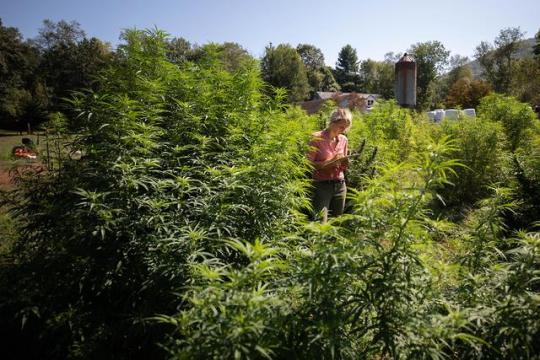
Roxann Roche doesn’t expect to get rich farming. She and her husband both have other jobs. She's a gardner. He's a mechanic. And like many for the past few years, their small family farm in northwestern Connecticut operated at a loss.
“It’s really hard to make a living farming,” Roche (pictured above) said. “We are always looking for something that has value.”
So, like dozens of other Connecticut farmers this season, she’s growing hemp.
For decades, growing hemp in America was illegal. Despite centuries of harvests, the crop, which is a close relative of marijuana, became ensnared in the nationwide war on drugs.
But recent updates to federal and state laws changed that, which means in the coming weeks, dozens of Connecticut hemp fields — the first in more than a generation — will be ready for harvest.
“I’m learning how to do this, just like everybody else is. This is such a new thing. There’s a lot of information out there. Some of it is right. Some of it is wrong,” Roche said.
Changes to the federal Farm Bill in 2014 paved the way for farmers to begin growing hemp, if they follow certain state guidelines. Connecticut passed its guidelines earlier this year and, so far, it has licensed more than 80 growers.
Hemp is a cannabis plant. Bred for its non-psychotropic cannabidiol, which is called “CBD.” That makes hemp different from marijuana, which is filled with more “THC” that produces that plant’s high.
But right now, CBD is riding its own high. Harvested from plants like these to fuel a wellness industry of lotions and pills projected by some to grow into billions of dollars in the next decade.

Roche carefully worked her way through an electric fence that keeps livestock clear of dozens of penned-in hemp plants. She took out a pair of clippers and a small brown bag and began snipping her plants, taking off a few inches of flowers, where there is the highest concentration of CBD.
The flowers were put in a bag, which she later took to the Connecticut Agricultural Experiment Station for testing.
It’s a test that’s required by state law. Because if THC levels test “hot,” that hemp plant is now, technically, a marijuana plant. Which means it’s destroyed, at a total loss for the farmer.
And Roche said growing CBD hemp carries other risks.
“I’ve seen a lot — surprisingly — a lot of different kinds of pests.”
Like crickets on her plants and sap-sucking aphids that can damage leaves.

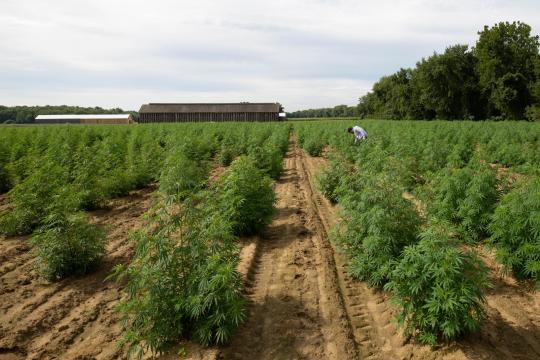
At another farm about 50 miles east, hemp farmer Eddie Kasheta checked in with UConn vegetable scientist Shuresh Ghimire.
This season, Ghimire has traveled around the state. Checking in with hemp farmers to help them keep an eye out for pests.
“In one field that I visited … 80 percent of the field was completely damaged by deer,” Ghimire said.
And Ghimire’s been working to get another message across: male plants are bad.
That’s because males release pollen. If that pollen gets into female hemp flowers, “the whole plant directs its energy toward seed production,” Ghimire said.
Which drastically cuts down CBD and a farmer’s profit.
So Ghimire said culling male plants is essential.
“You are getting dollars for percent CBD. So if you have higher CBD, that means you are getting more money.”

Still, how much money is an open question, said Brent Young with Colorado State University Extension.
His state has been growing hemp for several years alongside marijuana.
Young said if you want to know the price for a more established crop like corn, you can just whip out your smartphone and look it up.
“Unfortunately, right now, that’s not the case with hemp,” Young said. “If someone wanted to know what the price of hemp seed or hemp fibre, or hemp flower for CBD — we have no idea what it is.”
Young said that’s a big risk.
“The buyer typically has more information because they’re buying from multiple sources,” Young said. “The farmer tends to be more isolated in that situation and just not aware of what’s being paid for the commodity.”
Unlike more established crops, there aren’t universal standards for the seeds that farmers can buy.
“What I might think is good seed and what you might think is good seed are two different things, possibly. Because we don’t have those standards,” Young said.
Still hemp farms continue to grow. In Colorado, Young said there are about 80,000 acres registered to grow hemp. In New England, all states except New Hampshire have issued licenses to hemp growers over the past five years.

Back at RD Farm in northwestern Connecticut, Roxann Roche said her investment in hemp wasn’t huge. About fifteen-hundred bucks.
“We are being optimistic but cautious. I think most farmers are,” Roche said.
So if the crop doesn’t pan out, she said her farm will be OK.
But Roche said, either way, she wants to grow hemp again next season.
After all, for a crop that’s been out of Connecticut soil for decades, it might take a few growing seasons for farmers and regulators to beat their way through all the weeds.
14 notes
·
View notes
Photo

For the past decade, Connecticut’s residential electric customers have paid bills that are among the highest in the continental United States, but there isn’t one grand explanation for Connecticut’s sky-high electric bills.
The reality is more complicated, said Joseph Rosenthal, an attorney with the state Office of Consumer Counsel.
“It’s a hundred different things,” Rosenthal said.
Here’s one example: economics. Connecticut’s salaries are above the national average. But layered on top of that, Rosenthal said, are bigger economic trends: like a decline in industrial electric customers.
Those are the big-time manufacturers who used to suck up lots of electricity, which helped to offset costs for residents.
“We have less industrial load then we used to,” Rosenthal said. “It can make electricity cheaper for everybody when you a high-revenue customer like that.”
Then there are resource issues. In-state wind and hydro are bad or non-existent. Nearly 40 percent of Connecticut’s electric consumption comes from natural gas, but there is an issue there, too.
“All the natural gas that comes here has to come from somewhere else, typically from an interstate pipeline,” Rosenthal said.
All that combines to make for high prices. Really high prices.
According to the federal Department of Energy, Connecticut has the highest average retail electricity price among the lower 48 states.
That’s creating an affordability problem, said Taren O’Connor, an associate rate specialist at the Office of Consumer Counsel.
“We have a pretty high number of consumers in Connecticut that are not able to pay their electric bill,” O’Connor said.
For Eversource, about 1 in every 5 residential consumers was behind on their electric bill, as of spring 2018.
Ratepayers at the state’s two big utilities, Eversource and UI, owed a collective unpaid balance of more than $180 million.
O’Connor says those hardship numbers have, unfortunately, not gone down in recent years.
(Image Credit: Creative Commons, woodleywonderworks)
8 notes
·
View notes
Photo
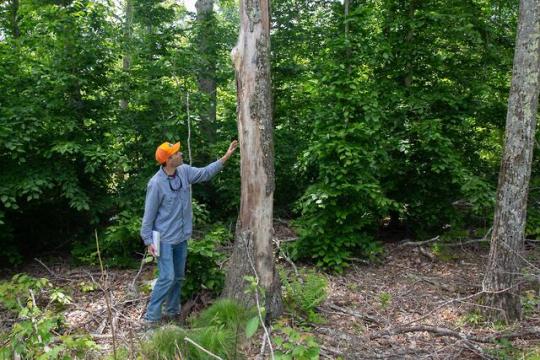
In recent years, an invasive insect called the gypsy moth has spelled doom for countless New England trees. From 2016 through 2018, it’s estimated gypsy moths defoliated more than 2 million acres in southern New England, which means a lot of cleanup for foresters.
But among all that destruction there is some good news: gypsy moth populations are, finally, declining.
Dan Evans (pictured above) drove a pickup truck down a bumpy road in Connecticut’s biggest state forest. He’s the forester for Pachaug State forest, and he wound his way up a trail that was closed in 2017.
“As we come up Firetower Road you can really start to see the damage in some of the roadside oak trees,” Evans said. “As we drive up the road you’ll certainly notice the fine limb material on the sides of the road falling out of the overhead trees here.”
It’s dead scarlet oak. Killed by gypsy moths. An invasive insect which, in high numbers, can rapidly eat up leaves and kill off trees.
Usually, rain activates a fungus that keeps gypsy moth populations in check. But when it doesn’t rain, gypsy moths can flourish in trees and bring with them their own type of precipitation.
“If we were standing in this forest in 2016 or even 2017, we’d be feeling a ghost rain on our face. That’s what the foresters from the 1980s always referred to the gypsy moth evidence as: a ‘ghost rain,’” Evans said. “The leaf particles, and excrement from the insect coming down from the canopy.”

(Dan Evans, right, says a recent survey found more than 19,000 hazard trees on state land. Of those, about 8,500 were oaks. A high percentage of oak mortality can be attributed to gypsy moths, which flourished in recent years.)
Gypsy moth numbers spiked in southern New England in 2017, after nearly two years of drought paved the way for one of the worst outbreaks since the early 1980s. As we walked, the damage was all around us.
“Almost all of the oak trees in this stand are dead,” Evans said.
Damage was also severe in neighboring Rhode Island and Massachusetts.
Tawny Simisky, an entomologist with UMass Extension, said Massachusetts saw defoliation numbers peak near 1 million acres in 2017.
But since then, she’s seen a big improvement.
“My hope is that in 2020 there will be very few folks, certainly in Massachusetts, with noticeable populations of gypsy moth,” Simisky said. “My hope is that we’re … at the tail end of this outbreak.”
The reason? A lot of rain supercharged a fungus called entomophaga maimaiga. It’s really good at killing off gypsy moth caterpillars.
Back at Pachaug State Forest, Forester Dan Evans said it’s good that insect numbers are dropping, but work still remains.

(Evans points out some of the damage done to a tree in Pachaug State Forest.)
“This gypsy moth outbreak has really changed our work plan over these past three years where we’ve been very much focused on public safety,” Evans said.
Evans said the risk presented by dead trees grows larger as time goes on. Bigger limbs will fall, and, if the trees aren’t cut, roots could rot and potentially topple the whole tree.
In Pachaug, about 4,000 trees are at risk. About 1,200 have been removed to date.
“You see that tree over there with an orange dot on it? That’s one that was identified in our hazard tree assessment process,” Evans said.
But there’s still a lot of life in the forest. Evans shuffles through the brush, showing me a seedling.

(An oak seedling grows in the sunlight in Pachaug State Forest earlier this year.)
“Our future forest getting started here, Evans said. “Some good vigorous young oak seedlings started in full sun conditions. I’m pretty darn confident that some day, some forester is going to be able to manage this as a dominant overstory white oak in this location.”
About 85 years in the future. But for now, Evans’ concerns are more immediate. Making the forest safe for hikers and keeping his fingers crossed that rain continues to keep the gypsy moth in check.
(Image/Text Credit: Patrick Skahill, Connecticut Public Radio)
6 notes
·
View notes
Photo

A road that cuts through a dusty Connecticut farm bisects what could be the past and future of Connecticut farming. On one side is broadleaf tobacco, a staple crop of Connecticut farms for generations. On the other, delicate hemp plants, swaying in the July heat.
Eddie Kasheta owns this land in South Windsor. For decades, it’s been a spot where his family grew tobacco.
“When the grandparents started the farm, tobacco was king,” Kasheta said.
But times have changed. Kasheta said if farmers want to survive, they need to change with it.
“With the failing[s] of the market, and the up and down of the prices — and the economy — you’re forced to go into other ventures and try other things.”
Today, he’s watching as thousands of hemp plants go into the ground.
“There are so many uses,” Kasheta said. “Brake linings, sneakers. Rope. And then you have the hemp seed that they extract oil from.”
Hemp and marijuana are both types of cannabis. But hemp lacks the chemicals needed to produce a high. What hemp does have is cannabidiol, or CBD, a non-psychoactive chemical compound that has found advocates in both the wellness and medical industry.

(Eddie Kasheta owns this plot of land in South Windsor. It's now home to thousands of hemp plants, which will be monitored as part of a pilot program set up by the state of Connecticut.)
According to a recent article in The New York Times, sales of CBD in the United States could be $16 billion by 2025.
Kasheta has partnered with Incredible Edibles, the latest business venture of Edible Arrangements founder Tariq Farid, which hopes to eventually use the CBD powder as an additive to drinks and baked goods.
Farmer Owen Jarmoc and his family started growing these as seedlings in a greenhouse just a few weeks back. They’re tiny, just a few inches tall. But, when the plants are ready for harvest in a few months, they’ll be several feet high.
Jarmoc said he’s worried about how they’ll do outside on the farm.
“There’s no consensus at all in the marketplace about how to grow this. What’s the best technique,” Jarmoc said.
That’s because for decades, it wasn’t legal to grow hemp. But the 2014 federal farm bill changed that, setting up a pilot program that allows farmers to grow hemp under strict conditions.
It took Connecticut a few years to set up its own pilot program. Governor Ned Lamont signed off on the idea in May. Since then, state Commissioner of Agriculture Bryan Hurlburt said the pilot program signed up 66 licensed growers.

(Hemp plants go into the ground on Wednesday, July 17, 2019. Around 50,000 seedlings are expected to be planted on this 20-acre plot.)
“Hemp will be the new tobacco of a hundred years ago,” Hulburt said. “When every farm, or many farms, had five or ten acres of broadleaf tobacco, because it was a high-value cash crop. That was the crop that stabilized the rest of the farm operation.”
As part of the pilot program arrangement, UConn will send out field scientists to monitor the plants’ CBD levels and collect growing data, which it will make publicly available.
Shuresh Ghimire, an extension vegetable educator at UConn, said that information will provide guidance for farmers new to growing hemp. And that next year, farmers will know a lot more about the pitfalls to avoid when it comes to growing hemp.
“There will be problems, obviously,” Ghimire said. “It’s a field crop so there will be disease and insects.”

(Edible Arrangements founder Tariq Farid in South Windsor on Wednesday, July 17, 2019. Farid is launching "Incredible Edibles," a joint-venture with several local farmers to cultivate CBD, a non-psychoactive chemical found in hemp plants, which has recently caught on in parts of the wellness and medical industry.)
But in the meantime, Jarmoc said data collection will provide hemp producers like Incredible Edibles something else: traceability.
“It’s really important,” Jarmoc said. “You can go buy CBD right now all over the marketplace, but some of it doesn’t even have CBD in it.”
Ron Reynolds, with Incredible Edibles, said setting up traceability standards while researching hemp, and its potential uses in food, are two of the big reasons why his company wanted to get into the CBD market in Connecticut.
“Part of what were are doing here is humbly learning,” Reynolds said. “Because this plant, no matter what definition you want to use, has really not been around for about 80 to 100 years.”
Jarmoc said he’s hopeful the seedlings that went in the ground today do well. If they do, he said next year, they’ll plant some more.
But right now, Jarmoc said hemp in Connecticut is far from a sure bet. And the first true test for the state’s pilot program will be October, when these thousands of hemp plants will, hopefully, be ready for harvest.
(Text/Photo Credit: Patrick Skahill, Connecticut Public Radio)
12 notes
·
View notes
Photo


Its wingspan is longer than an American football field. And one day, this massive airplane could ferry rockets carrying satellites into space.
This month, “Stratolaunch,” what’s being billed as the “world’s largest all-composite aircraft,” successfully completed its first flight over the Mojave Desert in California.
Pilots from Scaled Composites, LLC, an aviation firm founded by legendary aeronautical engineer Burt Rutan, flew the record-setting craft.
Rutan designed Voyager, another record-setting craft, which in 1986 was the first plane to fly around the world without stopping or refueling.
Read more: Stratolaunch Completes Historic First Flight of Aircraft
(Image Credit: Scaled Composites, LLC)
11 notes
·
View notes
Photo

“The brains of dead pigs have been somewhat revived by scientists hours after the animals were killed in a slaughterhouse.
“The Yale University research team is careful to say that none of the brains regained the kind of organized electrical activity associated with consciousness or awareness. Still, the experiment described Wednesday in the journal Nature showed that a surprising amount of cellular function was either preserved or restored.
“The implications of this study have staggered ethicists, as they contemplate how this research should move forward and how it fits into the current understanding of what separates the living from the dead.”
Read the full story on NPR: “Scientists Restore Some Function In The Brains Of Dead Pigs”
Text Credit: NPR / Image Credit: (Stefano G. Daniele and Zvonimir Vrselja, Sestan Laboratory, Yale School of Medicine)
12 notes
·
View notes
Photo

Recently, part of Harkness Memorial State Park in Connecticut caught fire.
But this shoreline blaze wasn’t a disaster.
It was actually a carefully-planned “burn” aimed at preserving what’s been called the “last remnant” of eastern prairie in the state.
(Above: Dan Evans is a forester at Pachaug State Forest in Voluntown. Along with a treaded vehicle called a "bombardier," Evans' job is to "hold" the fire. He watches closely to maintain established perimeter lines as seven acres of grass at Harkness burns.)
Before fifteen acres are set to flame, workers scorch ground, creating a blackened “safe zone” to contain the fire.

Each member of the crew has a specific role. Bruce Villwock, district fire warden, hauls a hose used to wet down land adjacent to the planned blaze.

Working with Villwock is Joe Burnham, seasonal fire control staff and a full-time Mansfield firefighter. Today, Burnham is in charge of the site’s water tanker, aptly named “Burnham.”

Rich Schenk is the burn’s safety officer. He’s one of three people today who will be “in the flames,” working the radio and making sure the burn goes according to its detailed plan. “I’ve been doing it for thirty something years,” Schenk said. “In Connecticut and I travel nationally.”

Villwock and Burnham reel in the hose.
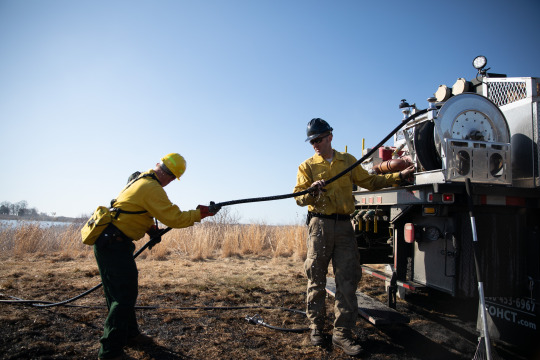
Two torches rest on the tailgate of a truck. For wildlife biologist Jane Seymour, this is her second burn. “One reason that we use the fire to manage wildlife habitat is to keep it at that early stage,” Seymour said. “We’re trying to save the last remnants of these grassland habitats for the species that depend on them.”

For today’s burn, the crew is 14 people: one biologist, four foresters, five fire control staff, and four park staffers. “The purpose of this burn is to maintain the fields and native grasses,” said Helene Hochholzer, the state’s forest protection supervisor. “While providing habitat for some of the grassland birds.”

Forester Emery Gluck is today’s “burn boss.” Before Gluck sets torch to grass, he warns his crew about the dangers of fire, even in a controlled setting. “These flames will probably go between a few feet in the tall grass,” Gluck said, “to well over ten-fifteen feet with a head fire. And burn very fast.”

Hear The Story: A Snapshot Of A Controlled Burn On Connecticut’s Coast
(Image Credits: Patrick Skahill, Connecticut Public Radio)
46 notes
·
View notes
Photo

Renewable energy projects have been growing across New England in recent years. And while offshore wind and grid-scale solar have gotten lots of the attention -- a smaller, more community-oriented way of getting power has been steadily taking hold, “shared solar.”
“Typically you have to own a home. You have to have good credit. You have to have a good facing roof in order to get solar put on your house,” said Jeff Pipeling with CTEC Solar.
But with shared solar, you don’t need all that. You can sign up for an array that’s located somewhere else. Think of it like a community garden for energy.
Now, after several years of planning, the state’s first shared solar array will soon be online in Bloomfield. But when it comes to the ‘cost and benefits’ of shared solar power on your electric bill, the story is complicated.
Read the full story, WNPR: "In Connecticut, The Costs And Benefits Of Shared Solar Are Tough To Calculate”
(Image Credit: Ryan Caron King, Connecticut Public Radio)
0 notes
Photo

After sitting in storage for nearly half of a century, a trove a moon of rocks will soon be opened and studied by scientists.
The samples were set aside by the Apollo missions with the idea that future technology would be better able to study these moon rocks.
Now, it seems, that time has come. NASA announced this week it selected nine teams and awarded a total of $8 million for the project. Here are some details from NASA:
The particular sample these teams will study came to Earth vacuum-sealed on the Moon by the Apollo 17 astronauts Harrison Schmitt and Gene Cernan in 1972.
The Apollo 17 sample comprises about 800 grams (1.8 pounds) of material, still encased in a “drive tube” that was pounded into the lunar regolith to collect a core of material. That core preserves not just the rocks themselves but also the stratigraphy from below the surface so today’s scientists can, in a laboratory, study the rock layers exactly as they existed on the Moon. The core has been carefully stored at NASA’s Johnson Space Center in Houston, Texas, since December 1972.
Read the full release: NASA Selects Teams to Study Untouched Moon Samples
(Image Credit: Eugene A. Cernan, Apollo 17 Commander / NASA Caption: “11 December 1972 -- Scientist-astronaut Harrison H. Schmitt collects lunar rake samples at Station 1 during the first Apollo 17 extravehicular activity (EVA) at the Taurus-Littrow landing site.”)
4 notes
·
View notes
Photo


This stork-like bird is probably best known for, you guessed it, its massive beak. In fact, the bill is so big, it’s earned the bird a nickname: “whalehead.” But you won’t find this bird in the ocean, its preferred habitat are the marshes and freshwater swamps of east Africa.
Today, enjoy a few facts about the shoebill (Balaeniceps rex):
It’s okay to admit. To some eyes, these birds could be seen as a tad frightening. They’re big, with some shoebills standing over 4 feet (1.22 meters) tall and weighing around 12 pounds (5.4 kg).
Shoebills have a large prominent beak that looks a lot like a wooden shoe. They also have surprisingly large feet (see photo above), which may help them navigate shallow waters surfaced with floating vegetation.
When it comes to mating, shoebills are monogamous. Both males and females participate in all aspects of the chick rearing. And as the University of Michigan notes, shoebills engage in “egg watering,” filling their beaks with water and dumping that on eggs to help keep them cool.
As Audubon points out, the diet of a shoebill is diverse and ranges from eels and lungfish to baby crocodiles. While hunting, the birds will stand and wait or slowly stalk through vegetation in shallow water until they can find a meal.
(Image Credits: Wikimedia Commons / Source: University of Michigan: Animal Diversity Web, IUCN Red List (Vulnerable), Wikimedia Commons, Audubon)
8 notes
·
View notes
Photo

Hemp is used in everything from beauty products to clothing. And the University of Connecticut is teaching a whole class on growing just this one kind of plant.
Around 300 students are taking the course. Some days they study seed selection and lighting. On others, it’s irrigation and nutrients.
Instructor Matthew DeBacco said the goal is to present a scientifically-backed way to grow while dispelling myths that, for years, may have passed between illicit growers.
“Friends of friends,” DeBacco said. “Sharing information that may have absolutely no scientific basis.”
Read the full story: WNPR, “UConn Students Experiment With Classroom Cannabis”
(Image Credit: Ryan Caron King / Connecticut Public Radio)
6 notes
·
View notes
Photo


“The anomaly is known as a bilateral gynandromorph. In plain language: Half its body is male and the other half is female. “This remarkable bird is a genuine male/female chimera,” says Daniel Hooper, a postdoctoral fellow at the Cornell Lab of Ornithology, in an email.
“Gynandromorphs, known as “half-siders” among ornithologists, are uncommon but not unheard of. They likely occur across all species of birds, Hooper says, but we’re only likely to notice them in species where the adult males and females look distinct from each other, a trait known as sexual dimorphism. “Cardinals are one of the most well-known sexually dimorphic birds in North America—their bright red plumage in males is iconic—so people easily notice when they look different,” Hooper says.”
Read the full story: National Geographic, “Rare half-male, half-female cardinal spotted in Pennsylvania”
Read More: The New York Times, “A Rare Bird Indeed: A Cardinal That’s Half Male, Half Female”
(Image Credit: Creative Commons, DrPhotoMoto / Image Caption Top: A female cardinal. Bottom: A male cardinal.)
27 notes
·
View notes
Photo
Wow, what a bird. -Patrick
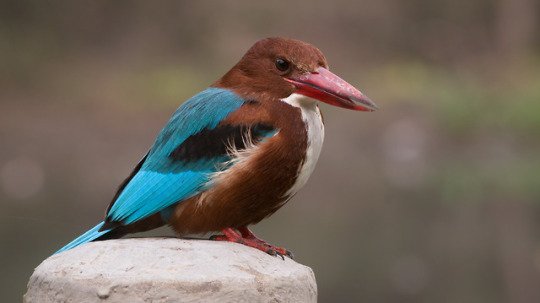
Wikipedia picture of the day on February 4, 2019:
White-throated kingfisher near Jargari, Ludhiana district, Punjab.
Learn more.
7 notes
·
View notes
Photo

Hemlock trees in Connecticut have been having a tough go of it thanks, in part, to a small sap-sucking insect: the hemlock woolly adelgid.
First identified in Connecticut in the 1980s, this invasive Japanese insect eats through conifer trees and has contributed to die-offs of native conifers like the Eastern hemlock (pictured above with a woolly adelgid infestation).
But Carole Cheah with the Connecticut Agricultural Experiment Station said something might finally be causing adelgids to die off: all this cold weather.
“I have been looking for adelgids since the summer,” Cheah said. “I have been hardly able to find any adelgids at all. Even in places where I used to be able to collect adelgids.”
For years, Cheah’s been going out to look for adelgids all over Connecticut.
Woolly adelgids are active during more mild parts of the season, when temperatures are in the 30-to-40-degree Fahrenheit range.

(Slide-mounted HWA adult (left) and developing HWA (right))
But through years of sampling, Cheah said she’s found extreme winter temperature drops (at least -11 F in the northwest corner, -8 F in central Connecticut, or -6 F along the shore) are killing massive numbers (more than 90 percent) of adelgid populations.
So are successive days of sub-zero temperatures.
“My feeling is that, at least with regard to the adelgid, we no longer have such a serious threat as we had just a decade ago,” Cheah said. “I feel very optimistic about the future for our eastern hemlocks.”
But Cheah cautioned it’s a tempered optimism.
Hemlocks are susceptible to drought, which notably impacted the state in 2016 and 2017.
Cheah also said increased snowfalls could actually insulate surviving adelgids, helping them to ride out extreme winter weather.
Meanwhile, northwestern adelgid populations appear to be developing some cold-resistance, and urban “heat islands” could warm up adelgids in more developed portions of the state.
Then there’s another, more cold-tolerant, insect, which may be taking the adlegid’s place: the elongate hemlock scale.
“We should not take our eye off the [elongate hemlock] scale, because that is not going to be as impacted by the winters,” Cheah said. “Even though the hemlock woolly adelgid may have lessened its impact on the hemlocks, I believe the scale needs to be further researched and is definitely impacting them now.”
(Image Credits: Scott M Salom, Virginia Tech / U.S. Department Of Agriculture & Nathan Havill / USDA Forest Service)
1 note
·
View note
Photo

“As bobcats return to New England following decades of conservation and forest regrowth, biologists want to learn more about what these mysterious wild cats are up to.
So using tools like GPS collars, Hawley and his team are examining bobcat diets and fertility rates, trying to unravel how the cats act in the wild, and increasingly, in our backyard.
‘Are bobcats in more urban areas using different habitat? Or different resources?’ Hawley said, comparing the city cats to their more rural counterparts. ‘Are they using it at different times of the day? Are they moving at different times?’”
Read/hear the full story and see pictures from Patrick’s visit to a bobcat lab @ WNPR: “What Are The Secrets Of Connecticut’s Bobcats?”
(Image Credit: Patrick Skahill, Connecticut Public Radio)
276 notes
·
View notes
Photo

“Church’s woolly mammoth research is just one of several de-extinction projects—there are about ten underway now—that aim to use genetics to restore lost species. In her book “The Re-Origin of Species,” the Swedish science journalist Torill Kornfeldt travels the world meeting the scientists and conservationists involved in this movement. In California, she talks with Ben Novak, a scientist obsessed with bringing back the passenger pigeon—a bird that once travelled in flocks that were so giant and dense, Novak tells her, that they “swept through the landscape, with the same effect as forest fires.” In upstate New York, a researcher is working toward restoring the American chestnut, which was decimated by blight in the late eighteen-hundreds. Until then, chestnuts were so prevalent in the eastern half of the United States that, when their white blossoms fell in the spring, the hillsides looked like they were covered in snow; in the fall, their sweet, starchy nuts served as a free, abundant harvest. At Australia’s Sea Simulator aquarium, resurrection scientists are working on coral, which faces an existential threat from the rapid warming and acidifying of ocean waters.
Read the full story: The New Yorker: The Woolly Mammoth Lumbers Back Into View
(Image Credit: Wikimedia Commons)
6 notes
·
View notes
Photo

January is shaping up to be an exciting month for the moon.
Nearly 50 years after the Apollo 11 mission put people on our nearest celestial neighbor for the first time, China’s Chang’e-4 mission marked another lunar milestone Thursday: visiting the far side of the moon.
So far, all lunar missions have landed on the moon’s near-side. According to Chinese state media, Chang’e-4 (the latest in a series of Chinese lunar missions) targeted the side that’s always out of Earth view due tidal locking.
What the far side of the moon looks like wasn’t known to us until it was photographed by the Soviet Luna 3 mission in 1959.
China’s latest mission (which includes a lander and a rover) is slated to do some interesting research. According to The New York Times:
“The instruments will probe the structure of the rocks beneath the spacecraft and study the effects of the solar wind striking the lunar surface. Chang’e-4 will also test the ability of making radio astronomy observations from the far side of the moon, without the effects of noise and interference from Earth.
“According to the Xinhua news agency, Chang’e-4 is also carrying an intriguing biology experiment to see if plant seeds will germinate and silkworm eggs will hatch in the moon’s low gravity.”
Both Israel and India are planning additional lunar missions in 2019. And China is readying another Chang’e mission, which ultimately could return lunar samples from the moon’s surface back to Earth.
Read the full story: Rocket Launches, Trips to the Moon and More Space and Astronomy Events in 2019
China’s Moon Landing: ‘New Chapter in Humanity’s Exploration of the Moon’
Note: This post was updated at 8:00 AM ET.
(Image Credit: NASA/NOAA)
19 notes
·
View notes